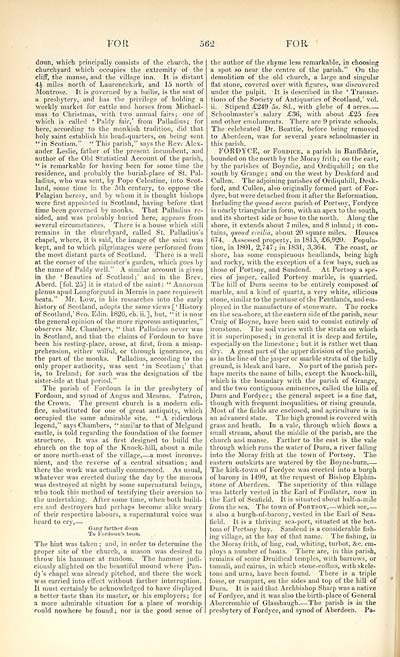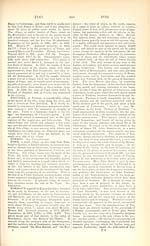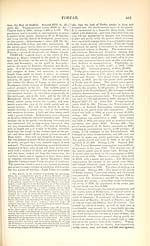Topographical, statistical, and historical gazetteer of Scotland > Volume 1
(656) Page 562
Download files
Complete book:
Individual page:
Thumbnail gallery: Grid view | List view

FOR
562
FOR
doun, which principally consists of the church, the
churchyard which occupies the extremity of the
cliff, the manse, and the village inn. It is distant
4£ miles north of Laurencekirk, and 15 north of
Montrose. It is governed by a bailie, is the seat of
a presbytery, and has the privilege of holding a
weekly market for cattle and horses from Michael-
mas to Christmas, with two annual fairs; one of
which is called ' Paldy fair,' from Palladius; for
here, according to the monkish tradition, did that
holy saint establish his head-quarters, on being sent
"in Scotiam." " This parish," says the Rev. Alex-
ander Leslie, father of the present incumbent, and
author of the Old Statistical Account of the parish,
" is remarkable for having been for some time the
residence, and probably the burial-place of St. Pal-
ladius, who was sent, by Pope Celestine, into Scot-
land, some time in the 5th century, to oppose the
Pelagian heresy, and by whom it is thought bishops
were first appointed in Scotland, having before that
time been governed by monks. That Palladius re-
sided, and was probably buried here, appeal's from
several circumstances. There is a house which still
remains in the churchyard, called St. Palladius's
chapel, where, it is said, the image of the saint was
kept, and to which pilgrimages were performed from
the most distant parts of Scotland. There is a well
at the corner of the minister's garden, which goes by
the name of Paldy well." A similar account is given
in the 'Beauties of Scotland;' and in the Brev.
Aberd. [fol. 25] it is stated of the saint: " Annorum
plenus apud Longforgund in Menus in pace requiescit
heata." Mr. Low, in his researches into the early
history of Scotland, adopts the same views [' History
of Scotland, '8\'o. Edin. 1826, ch. ii.], but, "it is now
the general opinion of the more rigorous antiquaries,"
observes Mr. Chambers, " that Palladius never was
in Scotland, and that the claims of Fordoun to have
been his resting-place, arose, at first, from a misap-
prehension, either wilful, or through ignorance, on
the part of the monks. Palladius, according to the
only proper authority, was sent 'in Scotiam;' that
is, to Ireland; for such was the designation of the
sister-isle at that period."
The parish of Fordoun is in the' presbytery of
Fordoun, and synod of Angus and Mearns. Patron,
the Crown. The present church is a modern edi-
fice, substituted for one of great antiquity, which
occupied the same admirable site. " A ridiculous
legend," says Chambers, " similar to that of Melgund
castle, is told regarding the foundation of the former
structure. It was at first designed to build the
church on the top of the Knock- hill, about a mile
or more north-east of the village, — a most inconve-
nient, and the reverse of a central situation; and
there the work was actually commenced. As usual,
whatever was erected during the day by the masons
was destroyed at night by some supernatural beings,
who took this method of testifying their aversion to
the undertaking. After some time, when both build-
ers and destroyers had perhaps become alike weary
of their respective labours, a supernatural voice was
heard to cry, — .
Gariff farthpr doun
To Fordoun's toun.
The hint was taken ; and, in order to determine the
proper site of the church, a mason was desired to
throw his hammer at random. The hammer judi-
ciously alighted on the beautiful mound where Pan-
dj's chapel was already pitched, and there the work
wis carried into effect without farther interruption.
It must certainly be acknowledged to have displayed
a better taste than its master, or his employers ; for
a more admirable situation for a place of worship
f ould nowhere be found ; nor is the good sense of
the author of the rhyme less remarkable, in choosing
a spot so near the centre of the parish." On the
demolition of the old church, a large and singular
flat stone, covered over with figures, was discovered
under the pulpit. It is described in the ' Transac-
tions of the Society of Antiquaries of Scotland,' vol.
ii. Stipend ,£249 5s. 8d., with glebe of 4 acres
Schoolmaster's salary £36, with about £25 fees
and other emoluments. There are 9 private schools.
The celebrated Dr. Beattie, before being removed
to Aberdeen, was for several years schoolmaster in
this parish.
FORDYCE, or Fordice, a parish in Banffshrie,
bounded on the north by the Moray frith ; on the east,
by the parishes of Boyndie, and Ordiquhill ; on the
south by Grange ; and on the west by Deskford and
Cullen. The adjoining parishes of Ordiquhill, Desk-
ford, and Cullen, also originally formed part of For-
dyce, but were detached from it after the Reformation.
deluding the quoad sacra parish of Portsoy, Fordyce
is nearly triangular in form, with an apex to the south,
and its shortest side or base to the north. Along the
shore, it extends about 7 miles, and 8 inland ; it con-
tains, quoad clvilia, about 20 square miles. Houses
674. Assessed property, in 1815, £6,920. Popula-
tion, in 1801, 2,747; in 1831, 3,364. The coast, or
shore, has some conspicuous headlands, being high
and rocky, with the exception of a few bays, such as
those of Portsoy, and Sandend. At Portsoy a spe-
cies of jasper, called Portsoy marble, is quarried.
The hill of Durn seems to be entirely composed of
marble, and a kind of quartz, a very white, silicious
stone, similar to the pentuse of the Pentlands, and em-
ployed in the manufacture of stoneware. The rocks
on the sea-shore, at the eastern side of the parish, near
Craig of Boyne, have been said to consist entirely of
ironstone. The soil varies with the strata on which
it is superimposed ; in general it is deep and fertile,
especially on the limestone ; but it is rather wet than
dry. A great part of the upper division of the parish,
as in the line of the jasper or marble strata of the hilly
ground, is bleak and bare. No part of the parish per-
haps merits the name of hills, except the Knock-hill,
which is the boundary with the parish of Grange,
and the two contiguous eminences, called the hills of
Durn and Fordyce ; the general aspect is a fine flat,
though with frequent inequalities, or rising grounds.
Most of the fields are enclosed, and agriculture is in
an advanced state. The high ground is covered with
grass and heath. In a vale, through which flows a
small stream, about the middle of the parish, are the
church and manse. Farther to the east is the vale
through which runs the water of Durn, a river falling
into the Moray frith at the town of Portsoy. The
eastern outskirts are watered by the Boyne-burn. —
The kirk-town of Fordyce was erected into a burgh
of barony in 1499, at the request of Bishop Elphin-
stone of Aberdeen. The superiority of this village
was latterly vested in the Earl of Findlater, now in
the Earl of Seafield. It is situated about half-a-mile
from the sea. The town of Portsoy, — which see, — .
s also a burgh-of-barony, vested in the Earl of Sea-
field. It is a thriving sea-port, situated at the bot-
tom of Portsoy bay. Sandend is a considerable fish-
ing village, at the bay of that name. The fishing, in
the Moray frith, of ling, cod, whiting, turbot, &c. em-
ploys a number of boats. There are, in this parish,
remains of some Druidical temples, with barrows, or
tumuli, and cairns, in which stone-coffins, with skele-
tons and urns, have been found. There is a triple
fosse, or rampart, on the sides and top of the hill of
Durn. It is said that Archbishop Sharp was a native
of Fordyce, and it was also the birth-place of General
Abercrombie of Glasshaugh.. — The parish is in the
presbytery of Fordyce, and synod of Aberdeen. Pa-
562
FOR
doun, which principally consists of the church, the
churchyard which occupies the extremity of the
cliff, the manse, and the village inn. It is distant
4£ miles north of Laurencekirk, and 15 north of
Montrose. It is governed by a bailie, is the seat of
a presbytery, and has the privilege of holding a
weekly market for cattle and horses from Michael-
mas to Christmas, with two annual fairs; one of
which is called ' Paldy fair,' from Palladius; for
here, according to the monkish tradition, did that
holy saint establish his head-quarters, on being sent
"in Scotiam." " This parish," says the Rev. Alex-
ander Leslie, father of the present incumbent, and
author of the Old Statistical Account of the parish,
" is remarkable for having been for some time the
residence, and probably the burial-place of St. Pal-
ladius, who was sent, by Pope Celestine, into Scot-
land, some time in the 5th century, to oppose the
Pelagian heresy, and by whom it is thought bishops
were first appointed in Scotland, having before that
time been governed by monks. That Palladius re-
sided, and was probably buried here, appeal's from
several circumstances. There is a house which still
remains in the churchyard, called St. Palladius's
chapel, where, it is said, the image of the saint was
kept, and to which pilgrimages were performed from
the most distant parts of Scotland. There is a well
at the corner of the minister's garden, which goes by
the name of Paldy well." A similar account is given
in the 'Beauties of Scotland;' and in the Brev.
Aberd. [fol. 25] it is stated of the saint: " Annorum
plenus apud Longforgund in Menus in pace requiescit
heata." Mr. Low, in his researches into the early
history of Scotland, adopts the same views [' History
of Scotland, '8\'o. Edin. 1826, ch. ii.], but, "it is now
the general opinion of the more rigorous antiquaries,"
observes Mr. Chambers, " that Palladius never was
in Scotland, and that the claims of Fordoun to have
been his resting-place, arose, at first, from a misap-
prehension, either wilful, or through ignorance, on
the part of the monks. Palladius, according to the
only proper authority, was sent 'in Scotiam;' that
is, to Ireland; for such was the designation of the
sister-isle at that period."
The parish of Fordoun is in the' presbytery of
Fordoun, and synod of Angus and Mearns. Patron,
the Crown. The present church is a modern edi-
fice, substituted for one of great antiquity, which
occupied the same admirable site. " A ridiculous
legend," says Chambers, " similar to that of Melgund
castle, is told regarding the foundation of the former
structure. It was at first designed to build the
church on the top of the Knock- hill, about a mile
or more north-east of the village, — a most inconve-
nient, and the reverse of a central situation; and
there the work was actually commenced. As usual,
whatever was erected during the day by the masons
was destroyed at night by some supernatural beings,
who took this method of testifying their aversion to
the undertaking. After some time, when both build-
ers and destroyers had perhaps become alike weary
of their respective labours, a supernatural voice was
heard to cry, — .
Gariff farthpr doun
To Fordoun's toun.
The hint was taken ; and, in order to determine the
proper site of the church, a mason was desired to
throw his hammer at random. The hammer judi-
ciously alighted on the beautiful mound where Pan-
dj's chapel was already pitched, and there the work
wis carried into effect without farther interruption.
It must certainly be acknowledged to have displayed
a better taste than its master, or his employers ; for
a more admirable situation for a place of worship
f ould nowhere be found ; nor is the good sense of
the author of the rhyme less remarkable, in choosing
a spot so near the centre of the parish." On the
demolition of the old church, a large and singular
flat stone, covered over with figures, was discovered
under the pulpit. It is described in the ' Transac-
tions of the Society of Antiquaries of Scotland,' vol.
ii. Stipend ,£249 5s. 8d., with glebe of 4 acres
Schoolmaster's salary £36, with about £25 fees
and other emoluments. There are 9 private schools.
The celebrated Dr. Beattie, before being removed
to Aberdeen, was for several years schoolmaster in
this parish.
FORDYCE, or Fordice, a parish in Banffshrie,
bounded on the north by the Moray frith ; on the east,
by the parishes of Boyndie, and Ordiquhill ; on the
south by Grange ; and on the west by Deskford and
Cullen. The adjoining parishes of Ordiquhill, Desk-
ford, and Cullen, also originally formed part of For-
dyce, but were detached from it after the Reformation.
deluding the quoad sacra parish of Portsoy, Fordyce
is nearly triangular in form, with an apex to the south,
and its shortest side or base to the north. Along the
shore, it extends about 7 miles, and 8 inland ; it con-
tains, quoad clvilia, about 20 square miles. Houses
674. Assessed property, in 1815, £6,920. Popula-
tion, in 1801, 2,747; in 1831, 3,364. The coast, or
shore, has some conspicuous headlands, being high
and rocky, with the exception of a few bays, such as
those of Portsoy, and Sandend. At Portsoy a spe-
cies of jasper, called Portsoy marble, is quarried.
The hill of Durn seems to be entirely composed of
marble, and a kind of quartz, a very white, silicious
stone, similar to the pentuse of the Pentlands, and em-
ployed in the manufacture of stoneware. The rocks
on the sea-shore, at the eastern side of the parish, near
Craig of Boyne, have been said to consist entirely of
ironstone. The soil varies with the strata on which
it is superimposed ; in general it is deep and fertile,
especially on the limestone ; but it is rather wet than
dry. A great part of the upper division of the parish,
as in the line of the jasper or marble strata of the hilly
ground, is bleak and bare. No part of the parish per-
haps merits the name of hills, except the Knock-hill,
which is the boundary with the parish of Grange,
and the two contiguous eminences, called the hills of
Durn and Fordyce ; the general aspect is a fine flat,
though with frequent inequalities, or rising grounds.
Most of the fields are enclosed, and agriculture is in
an advanced state. The high ground is covered with
grass and heath. In a vale, through which flows a
small stream, about the middle of the parish, are the
church and manse. Farther to the east is the vale
through which runs the water of Durn, a river falling
into the Moray frith at the town of Portsoy. The
eastern outskirts are watered by the Boyne-burn. —
The kirk-town of Fordyce was erected into a burgh
of barony in 1499, at the request of Bishop Elphin-
stone of Aberdeen. The superiority of this village
was latterly vested in the Earl of Findlater, now in
the Earl of Seafield. It is situated about half-a-mile
from the sea. The town of Portsoy, — which see, — .
s also a burgh-of-barony, vested in the Earl of Sea-
field. It is a thriving sea-port, situated at the bot-
tom of Portsoy bay. Sandend is a considerable fish-
ing village, at the bay of that name. The fishing, in
the Moray frith, of ling, cod, whiting, turbot, &c. em-
ploys a number of boats. There are, in this parish,
remains of some Druidical temples, with barrows, or
tumuli, and cairns, in which stone-coffins, with skele-
tons and urns, have been found. There is a triple
fosse, or rampart, on the sides and top of the hill of
Durn. It is said that Archbishop Sharp was a native
of Fordyce, and it was also the birth-place of General
Abercrombie of Glasshaugh.. — The parish is in the
presbytery of Fordyce, and synod of Aberdeen. Pa-
Set display mode to: Large image | Transcription
Images and transcriptions on this page, including medium image downloads, may be used under the Creative Commons Attribution 4.0 International Licence unless otherwise stated. ![]()
| Gazetteers of Scotland, 1803-1901 > Topographical, statistical, and historical gazetteer of Scotland > Volume 1 > (656) Page 562 |
|---|
| Permanent URL | https://digital.nls.uk/97445418 |
|---|
| Description | Volume first. A-H. |
|---|---|
| Attribution and copyright: |
|

